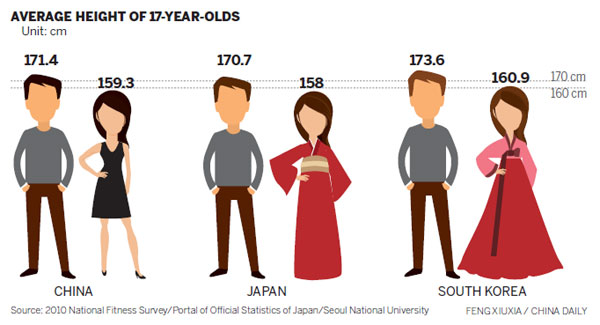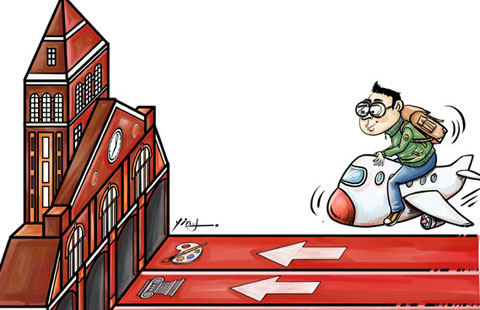Chinese teenagers not so short after all
Updated: 2014-05-06 07:27
(China Daily)
|
||||||||

Overall health declining as obesity rises, leading to calls for more exercise
|
 |
| Fatal obesity case sets the alarm bells ringing |
|
 |
| Walk for health, walk for love |
The claim that Chinese teens' average height falls short of their Japanese and South Korean counterparts surfaced at the National People's Congress in March, prompting public concern that students' fitness levels have plunged.
Specialists at a recent youth sports event shrugged off the comparisons, though they highlighted the importance of adequate exercise and diet as non-genetic factors behind overall health.
One fitness expert rejected the notion that Chinese youths are shorter than Japanese or South Koreans.
"The conclusion is inaccurate without official statistical analysis, and the comparison on height doesn't necessarily reflect people's fitness level in different countries," Tian Ye, director of the China Institute of Sport Science, said at the launch of preparations for the 2014 Sunshine Youth Sports event.
In March, Beijing educator and NPC deputy Wu Zhengxian claimed that the average Chinese teen is shorter than their Japanese or Korean peers.
Wu was not available to clarify her sources, but some figures suggest different results.
An average 17-year-old Chinese male in 2010 stood 171.4 centimeters in height, while the average female was 159.3 cm, according to figures from the National Fitness Survey released by the State Administration of Sport of China in 2011.
That's taller that Japanese youth of either sex.
According to e-Stat, the portal site of official statistics for Japan, the corresponding figures in Japan were 170.7 cm and 158 cm in 2011. A Seoul National University study showed South Korean males at 173.6 cm and females at 160.9 cm on average in the same period.
Rather than debate the merits of different heights, it would be more meaningful to push for increased physical education activities for students in China, said Li Guoping, director of the National Institute of Sports Medicine.
"Human body height is mainly decided by genetic factors and will be slightly affected by habitual exercise. It's not convincing to compare fitness level with the differences in height," Li said.
"However, the health status of Chinese teenagers is indeed worsening. We should work on providing children with more mandatory exercise on campus, which I believe would eventually boost the average height of Chinese."
Because of the overemphasis on academic excellence in China's exam-oriented education system, facilities and hours for physical education lag behind academic courses. This has resulted in a decline in overall student fitness levels, PE boosters say.
In the Chinese capital, of the 1.3 million primary and secondary school students sampled in the 2013 Beijing student physical fitness survey, 21.46 percent were obese while 62.96 percent suffered from myopia - less-than-perfect eyesight.
Some chronic diseases have also begun to hamper teenagers' development. Of 401 junior and senior high school students in one sample, 45.1 percent were diagnosed with fatty livers and 30.7 percent were found to be suffering from hypertension.
sunxiaochen@chinadaily.com.cn
Most Viewed
Editor's Picks

|

|

|

|

|

|
Today's Top News
Academic lauds US-China partnerships
Chinese premier proposes to upgrade China-Africa cooperation in six areas
E-commerce fuels Chengdu's trade growth
Deal signed to upgrade roads, grid in Ethiopia
Prospects brighter for foreign banks in China
Travel passes to DPRK made easier
Fast fashion gets sustainable
Yunnan's only panda perking up thanks to TV
US Weekly

|

|















